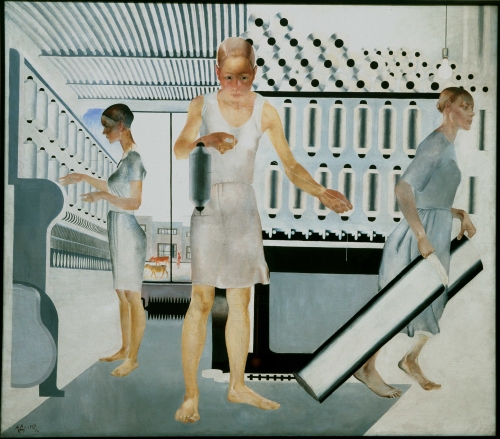Great art, shame about the curating

Christine Lindey reviews the current Royal Academy exhibition, and recommends the art - but not the didactic, vindictive and reactionary curation.
In January 1918 the Russian Soviet Republic was the first state in the world to officially support the avant-garde. Fired by the revolution’s socialist ideology, artists rejected the tsarist regime’s fussy forms and fusty techniques, to embrace the latest technology. They incorporated industrial forms into art, design, architecture and film which epitomised and promoted modernity. The avant-garde’s dynamic axes, rapid juxtapositions, startling close-ups and pared-down geometric forms expressed revolutionary dynamism. From Lyubov Popova’s designs to Dziga Vertov’s films, the cogs and wheels of mechanisation, the magic of flying machines and electrification’s bright rays embodied and promised social progress.

Liubov Popova, Space-Force Construction, 1921
It is always a joy to see these works and the Royal Academy’s exhibition Revolution: Russian Art 1917-1932 is no exception. But they are familiar, due to their depoliticisation and incorporation into the Western modernist canon in the early cold war which, by the same token, denigrated socialist realism and ignored Bolshevik pluralist cultural policies. So, to this day, Soviet representational art of the 1920s and 1930s has remained little known in the West and, by displaying the multifaceted Soviet art and design of the interwar years, the exhibition redresses a serious distortion of art history.
We encounter history paintings such as Alexander Deineka’s Defence of Petrograd, in which a stoic militia crunches determinedly through the snow, against a deadly, snow-laden sky. Liberated Bolshevik women soldiers take centre place, in a geometric composition formed by repeated upright bodies, diagonal rifles and the stark industrial bridge overhead. As in his other paintings and posters, Deineka modified modernist simplifications of form and space into a legible but contemporary style.

Alexander Deineka, The Defence of Petrograd, 1928
Many others sought such compromises, albeit in different ways. Aristarkh Lentulov’s Tverskoy Boulevard depicts its people and buildings in kaleidoscopic shapes which marry Parisian cubism with the riotous colours of Russian folk art, conveying the speed of modern Moscow life. Kuzma Petrov-Vodkin’s measured compositions combine discrete multiple viewpoints and intense primary colour to convey immersive and layered states of mind. In contrast, the academic realism of Issak Brodsky’s Lenin at Smolny has an almost hyperrealist presence, due it’s meticulously uniform rendering of all surfaces, be it an electric socket or the folds on Lenin’s jacket.
Unfortunately, instead of explaining these artists’ intentions, their works are framed as the last gasp of artistic freedom by focusing on the contents of a major 1932 exhibition. The Association of Artists for Revolutionary Russia, formed in 1922 to call for a progressive but accessible art, is not mentioned, nor is its influential manifesto. Yet its many members included Deineka, Brodsky, Lentulov, Petrov-Vodkin and Boris Grigoriev.

Pedrov-Vodkin, Self-Portrait, 1918
The exhibition’s stunning array of art and design is marred by vindictive, anti-Soviet curating. Wall texts and captions constantly point to the Revolution’s cruelties, failures and hardships, with not one word of praise for its achievements. Nor do they explain its difficult conditions, exacerbated by attacks from White Russians and international armies. More worryingly, the works are manipulated to score such curatorial points.
An example is the room ominously titled The Fate of the Peasants, which is a lachrymose lament for imagined, pre-revolutionary bucolic idylls. It greets us with Grigoriev’s lugubrious Land of the Peasants, which blends expressionism and cubism to convey impoverished peasants’ anger, dismay and oppression — as does his portrait of a careworn, wizened dairy maid. The wall text states that the villagers’ “ancient way of life was wiped out” by collectivisation. Yet even the Times Book of Russia in 1916 described the peasants’ lives as an “existence of privation of everything except vodka. His body was roughly clad. Bare necessities, reduced to a minimum, supported life. His soul steeped in ignorance.” And since both Grigoriev paintings are dated 1917, they indicted tsarist peasant life, not collectivisation.
The wall text to the room devoted to “Eternal Russia” informs us that “many” artists “were nostalgic for the beauty and charm of old Russia, rapidly disappearing under the boots of the proletarian masses.” It mourns the influence of the Orthodox religion and displays landscapes and depictions of onion-domed churches as if socialism and the love for one’s native land are mutually exclusive. And it includes Mark Chagall’s Promenade, dated 1917-18, which surely cannot represent nostalgia for tsarist days. That period was not rosy for this Jewish artist, whose tsarist shtetl past was characterised by brutal pogroms and exclusion of Jews from the professions. Chagall’s rose-tinted idealisation expressed the euphoria of being in love and it is this which projected he and his wife to metaphorically soar above shtetl life.

Marc Chagall, Promenade, 1918
In sum, this exhibition is a didactic attack on the Bolshevik revolution, permeated by the sour outlooks of descendants of dispossessed Russian emigres bemoaning their lost jewels, lands and servants. Go for the exhibition’s marvellous art and design. But arm yourself with scepticism about the curating.
This review was first published in the Morning Star, on March 11th. The exhibition runs until April 17.

Christine Lindey
Until she recently retired Christine Lindey was an Associate Lecturer in art history at the University of the Arts, London and at Birkbeck College, University of London. She is a visual arts critic for the Morning Star and her fifth book, Art for All: British Socially Committed Art c.1939 - c.1962, will be published in the near future.
